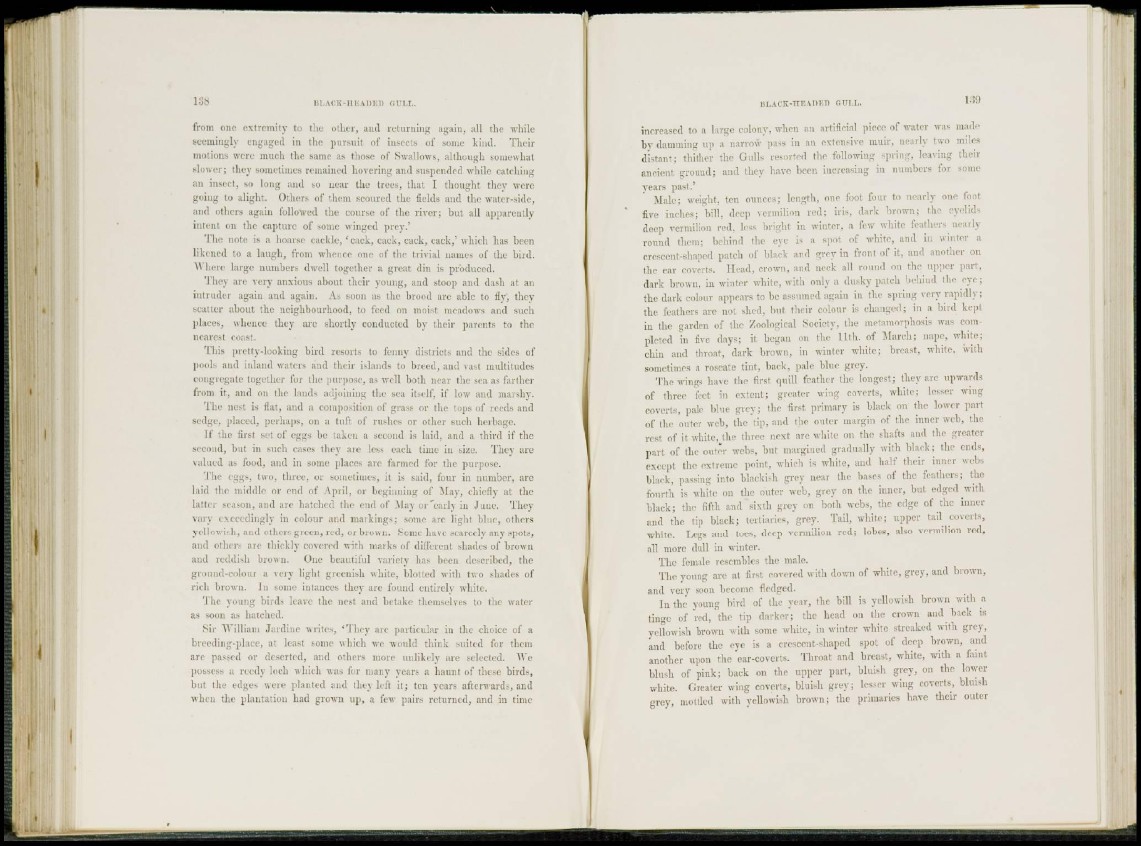
from one extremity to trie other, and returning again, all the while
seemingly engaged in the pursuit of insects of some kind. Their
motions were much the same as those of Swallows, although somewhat
Blower; they sometimes remained hovering and suspended while catching
an insect, so long and so near the trees, that I thought they were
going to alight. Others of them scoured the fields and the water-side,
and others again followed the course of the river; but all apparently
intent on the capture of some winged prey.1
The not)1 is a hoarse cackle, ' cack, cack, cack, cack,' which has been
likened to a laugh, from whence one of the trivial names of the bird.
Where large numbers dwell together a great din is produced.
They are very anxious about their young, and stoop and dash at an
intruder again and again. i.s s o o n as the brood are able to fly, they
scatter about the neighbourhood, to feed on moist meadows and such
places, whence they are shortly conducted by their parents to the
nearest coast.
This pretty-looking bird resorts to fenny districts and the sides of
pools and inland waters and their islands to breed, and vast multitudes
congregate together for the purpose, as well both near the sea as farther
from it. and o n the l a n d s adjoining the sea itself, if low and marshy.
The nest is flat, and a composition of grass or the tops of reeds and
sedge, placed, perhaps, on a tuft of rushes or other such herbage.
If the first set of eggs be taken a second is laid, and a third if the
second, but in such cases they are less each time in size. They are
valued as food, and in some places arc farmed for the purpose.
The eggs, two, three, or sometimes, it is said, four in number, are
hud the middle or end of April, or beginning of May, chiefly at the
latter season, and arc hatched the end of May or'early in June. They
vary exceedingly in colour and markings; some are light blue, others
yellowish, and others green, red, or brown. Some have scarcely any spots,
and other- are thickly covered with marks of different shades of brown
and reddish brown. One beautiful variety has been described, the
ground-colour a very light greenish white, blotted with two shades of
rich brown. In some intances they are found entirely white.
The young birds leave the nesl and betake themselves to the water
as soon as hatched.
Sir William Jar dine writes, 'They are particular in the choice of a
breeding-place, at least some which we would think suited for them
are passed or deserted, and others more unlikely are selected. We
possess a reedy loch which was for many years a haunt of these birds,
but the edges were planted and they left it; ten years afterwards, and
when the plantation had grown up, a few pairs returned, and in time
increased to a large colony, when an artificial piece of water was made
by damming up a narrow pass in an extensive muir, nearly two miles
distant; thither the Gulls resorted the following spring, leaving their
ancient ground; and they have been increasing in numbers for some
years past.'
Male; weight, ten ounces; length, one foot four to nearly one foot
five inches; hill, deep vermilion red: iris, dark brown; the eyelids
deep vermilion red, less bright in winter, a few white feathers nearly
round them; behind the eye is a spot of white, and in winter a
crescent-fib aped patch of black and frrey in front of it, and another on
the ear coverts. Head, crown, and neck all round on the upper part,
dark brown, in winter white, with only a dusky patch behind the eve;
the dark colour appears to be assumed again in the spring very rapidly;
the feathers are not shed, but their colour is changed; in a bird kept
in the garden of the Zoological Society, the metamorphosis was completed
in five days; it began on the 11th. of March; nape, white;
chin and throat, dark brown, in winter white; breast, white, with
sometimes a roseate tint, back, pale blue grey.
The wings have the first quill feather the longest; they arc upwards
of three feet in extent; greater wing coverts, white; lesser wing
coverts, pale blue grey; the first primary is black on the lower part
of the outer web, the tip, and the outer margin of the inner web, the
rest of it white, the three next are white on the shafts and the greater
part of the outer webs, but margined gradually with black; the ends,
except the extreme point, which is white, and half their inner webs
black, passing into blackish grey near the bases of the feathers; the
fourth is white on the outer web, grey on the inner, but edged with
black; the fifth and sixth grey on both webs, the edge of the inner
and the tip black; tertiaries, grey. Tail, white; upper tail coverts,
white. Legs and toes, deep vermilion red; lobes, also vermilion red,
all more dull in winter.
The female resembles the male.
The young are at f i r s t covered with down of white, grey, and brown,
and very soon become fledged.
I n the young bird of the year, the bill is yellowish brown with a
tinge of red, the tip darker; the head on the crown and back is
yellowish brown with some white, in winter white streaked with grey,
and before the eye1 is a crescent-shaped spot of deep brown, and
another upon the ear-covcrls. Throat and breast, white, with a faint
blush of pink; back on the upper part, bluish grey, on the lower
white. Greater wing coverts, b l u i s h grey; les.-er wing coverts, bluish
grey, mottled with yellowish brown; the primaries have their outer